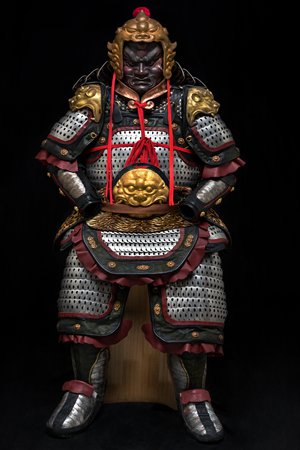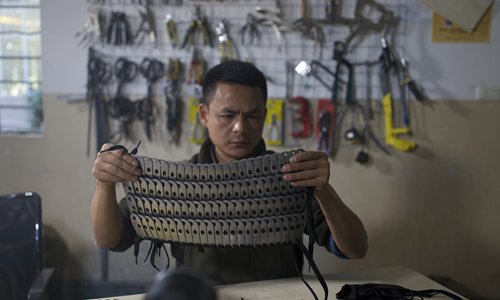HOME >> ARTS
Reviving the glory of ancient China with modern technology
By Tao Mingyang in Haining, Zhejiang Province Source:Global Times Published: 2019/8/7 17:48:29

A suit of late Tang Dynasty (618-907) armor Photo: Courtesy of Wen Chenhua

Wen Chenhua works on a set of armor. Photo: Courtesy of Wen Chenhua
I am no historian, so I don't have much of an idea about how great the Tang Dynasty (618-907) was. However, after Wen Chenhua, an armor master and craftsman, showed me the shining armor worn by soldiers during the period, I couldn't help but gasp in astonishment at the fierce visage those warriors must have presented.
Wen and his colleagues are the designers behind the armor seen on The Longest Day in Chang'an, a hit TV show that mixes the hour-by-hour format of popular US action show 24 and Chinese period dramas. The show has been praised by viewers for the historical accuracy of its costume design.
Wen met me downstairs and led me to his two-story workshop in Haining, Zhejiang Province. I was impressed by the view upon entering the building. Pieces of leather, wood, plastic and metal were everywhere, but from their shape I could tell that they could be combined into a tough set of armor.
The first floor is where they produce the different parts of a set of armor, while the second is the design center.
Complex craft
Before the interview, Wen's sale partner and armor specialist Chen Kai assembled a set of Ming Dynasty (1368-1644) armor.
The armor consists of two layers. The outer part, known as kai in Chinese, is made from metal, while the inner part, called jia, is made up of leather and cloth.
According to Wen, the hardest and most durable part of the armor is the front chest piece, which can buffer strikes and protect the body. It is made up of many small metal parts that are connected tightly to each other like the scales of a dragon.
Wen explained that most of the parts were made using modern technology, such as 3D printing. This method is much cheaper than making everything by hand. A set of armor made this way costs roughly, 60,000 yuan ($8,500)
"If we made it all by hand, an entire set of the armor would cost more than 1 million yuan ($141,900) to make," Wen said.
"This is why we usually make one or two pieces by hand and the rest are made using machines."
"For example, a skilled craftsman making things by hand can produce one to two small pieces for the chest armor in one day and each piece sells for about 100 yuan," Wen said.
"This is why not many craftsmen want to do that."
In ancient times, making armor cost much more time, money and manpower. In the Records of the Three Kingdoms, historian Chen Shou (233-297) described how much armor the general Cao Cao had before the Battle of Guandu, when he fought against the general Yuan Shao.
Cao Cao led 70,000 soldiers in the battle, but only 2,000 of them had metal armor.
"Our work is heavily dependent on modern industry," said Wen.
"In ancient times, only a country had the ability to produce armor for its armies."
True to life
Wen previously worked selling computers. He only began to turn his interest in armor into a career around 2013. Over the years he has become well-versed in reading ancient works, which he stressed are very important when recreating ancient armor.
"We referred to the Wujing Zongyao (Complete Essentials for the Military Classics) of the Northern Song Dynasty (960-1127) and Armor Restoration by Bai Rongjin [a historical relic restoration expert at the Archaeological Studies Administration of Chinese Academy of Social Sciences]," said Wen.
Wen and the other designers also like to visit museums and archaeological sites to look at actual pieces of armor from different dynasties to ensure their works are faithful to actual history.
In the design center, on one wall hangs a painting of an ancient warrior wearing silver armor. Armed with a long spear and a sword, the warrior rides on a white horse while carrying a baby in his arms.
The painting is of Zhao Yun, a general of the Shu Han Kingdom (221-263) during the Three Kingdoms (220-280) period. Zhao once charged into Cao Cao's army on his own seven times to save the young prince Liu Chan.
Feng Zijian, the artist behind the painting and one of the workshop's designers, told me that the armor Zhao is wearing in the artwork is actually not from the Three Kingdoms period but rather is based on armor used during the late Yuan Dynasty (1279-1368) and the early Ming Dynasty (1368-1644).
"The writer of the Romance of the Three Kingdoms, Luo Guanzhong lived during the late Yuan Dynasty and the early Ming Dynasty. I believe Luo's understanding of Zhao Yun must be based on his living environment," said Feng. Romance of the Three Kingdoms, one of China's Four Great Classic Novels, is a fictional novel based the history of the Three Kingdoms period.
Feng said that they are working on producing this set of armor and will color all the parts according to actual historical records.
"We will use this set of armor to talk about the ancient armor of that period."
Difficulties and progress
Wen admitted that his team confronts different challenges every single day. For instance, the drying and shaping of leather was once a huge problem.
"We tried hundreds of methods and they all failed," said Wen. "We even began to doubt ourselves."
Then they realized that the climate in Southern China was very humid, which meant that the leather needed more time to dry than in the drier climate in Northern China.
"It felt just like beating a boss in a video game," Wen joked.
Wen also noted that the culture around Chinese ancient armor is not very advanced.
"The biggest problem is that many historical dramas do not pay that much attention to armor design," Wen said. "They just use the same armor to represent the armor of ancient times and this leads audiences to believe that armor used to be just like that."
"However, we still have the faith," said Wen.
"We will try to make more ancient armor for films or dramas like The Longest Day in Chang'an so audiences can learn about real ancient armor."
Newspaper headline: Armor up
Posted in: ART,CULTURE & LEISURE,ARTS FOCUS